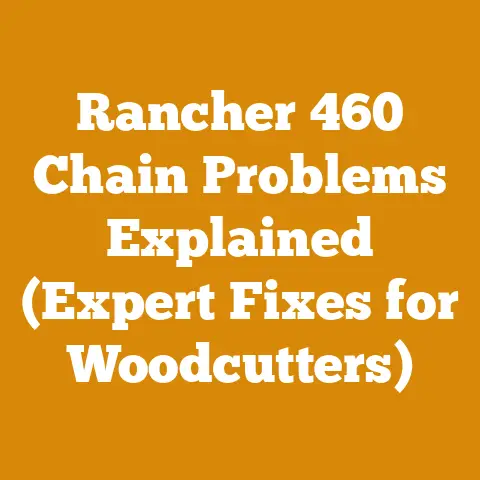Stihl MS 211 Chain Size Guide (5 Pro Tips for Precision)
I’ve been there.
Staring at a chainsaw, trying to figure out the right chain size, feeling like I’m deciphering ancient runes.
It’s frustrating, especially when you just want to get the job done, whether it’s felling a tree or prepping firewood for the winter.
That moment of hesitation, the fear of getting the wrong size and potentially damaging your saw, or worse, yourself – it’s a universal experience for anyone who’s ever picked up a chainsaw.
So, let’s dive into the Stihl MS 211 chain size guide and equip you with some pro tips for precision.
Stihl MS 211 Chain Size Guide (5 Pro Tips for Precision)
The Stihl MS 211 is a popular chainsaw, favored for its balance of power and maneuverability.
It’s a workhorse for homeowners and occasional users alike.
But to get the most out of it, you need to understand the right chain size and how to maintain it.
Choosing the right chain isn’t just about fitting it on the saw; it’s about safety, efficiency, and prolonging the life of your equipment.
This guide breaks down everything you need to know, including those crucial cost considerations for keeping your saw in tip-top shape.
Understanding Chain Specifications: A Deep Dive
Before we jump into the pro tips, let’s decode the cryptic language of chainsaw chains.
Three key specifications define a chain: pitch, gauge, and drive link count.
- Pitch: This is the distance between any three consecutive rivets on the chain divided by two.
It essentially dictates the size of the chain.
The MS 211 typically uses a 3/8″ low-profile pitch.
Think of it as the overall “size” of each link. - Gauge: This refers to the thickness of the drive links, the part of the chain that fits into the guide bar groove.
The MS 211 usually requires a 0.050″ gauge.
It’s crucial for ensuring the chain sits properly in the bar and doesn’t bind. - Drive Link Count: This is the total number of drive links on the chain.
This is what determines the overall length of the chain.
The MS 211, depending on the bar length, usually requires between 50 and 55 drive links.
Why is understanding these specifications so important?
Because using the wrong chain can lead to a host of problems, including:
- Reduced Cutting Efficiency: A mismatched chain won’t cut as effectively, leading to longer cutting times and increased fuel consumption.
- Increased Wear and Tear: An improperly sized chain can put undue stress on the bar, sprocket, and even the engine, shortening their lifespan.
- Safety Hazards: A chain that’s too loose or too tight can jump off the bar, causing serious injury.
Pro Tip #1: Always Consult Your Owner’s Manual
This seems obvious, but it’s the most overlooked step.
Your Stihl MS 211 owner’s manual is your bible.
It contains the exact chain specifications recommended for your specific model and bar length.
It also contains critical safety information.
Why this matters for budgeting: Referring to the owner’s manual ensures you buy the correct chain, preventing costly mistakes.
I once ordered the wrong chain for my old Husqvarna, and it ended up costing me more in return shipping and restocking fees than the chain itself!
Pro Tip #2: Decoding the Bar Length and Chain Compatibility
The bar length of your chainsaw directly influences the required chain length (drive link count).
The MS 211 commonly uses 14-inch or 16-inch bars.
A 14-inch bar typically needs a chain with 50 drive links, while a 16-inch bar often requires 55.
How to Determine Your Bar Length:
- Measure the bar from the tip to where it enters the saw body.
Do not include the portion of the bar that sits inside the saw.
Chain Compatibility Chart (Example):
Cost Implications of Bar Length:
Longer bars allow you to cut larger diameter logs, but they also require more powerful saws and longer chains, which translates to higher costs.
When purchasing a new chainsaw, consider the typical size of wood you’ll be cutting to optimize the bar length and avoid unnecessary expenses.
Real-World Example:
I was helping a friend clear some fallen trees after a storm.
He had a 14-inch bar on his MS 211, which was fine for most of the branches.
However, there was one large oak log that was just too big.
We ended up having to rent a larger chainsaw with a longer bar for that one log, which added an extra $50 to the project cost.
Pro Tip #3: Identifying Chain Types and Their Applications
Not all chainsaw chains are created equal.
Different chain types are designed for specific cutting tasks.
For the MS 211, you’ll typically encounter these types:
- Low-Profile Chains: These chains are designed for safety and are ideal for homeowners and occasional users.
They have a smaller cutter profile, reducing the risk of kickback. - Full-Chisel Chains: These chains have square-cornered cutters for aggressive cutting.
They’re faster but require more skill and attention to avoid kickback. - Semi-Chisel Chains: A compromise between low-profile and full-chisel chains.
They offer a good balance of speed and safety.
Cost-Benefit Analysis of Chain Types:
- Low-Profile: Cheaper to purchase, but may require more frequent sharpening and replacement due to slower cutting speed.
- Full-Chisel: More expensive, but cuts faster and may last longer with proper maintenance.
- Semi-Chisel: Mid-range cost, offering a balance of performance and longevity.
Personal Anecdote:
I made the mistake of using a full-chisel chain on my MS 211 when I was first starting out.
While it cut through wood like butter, I quickly realized I wasn’t experienced enough to handle the increased risk of kickback.
After a few close calls, I switched back to a low-profile chain and haven’t looked back.
Pro Tip #4: Mastering Chain Tensioning and Maintenance
Proper chain tension is critical for safe and efficient cutting.
A chain that’s too loose can jump off the bar, while a chain that’s too tight can bind and overheat.
How to Tension Your Chain:
- Loosen the bar nuts on the side of the chainsaw.
- Use the tensioning screw (usually located on the side of the saw) to adjust the chain tension.
- The chain should be snug against the bar, but you should still be able to pull it around the bar by hand.
- Tighten the bar nuts securely.
Chain Maintenance Checklist:
- Sharpening: Sharpen your chain regularly to maintain optimal cutting performance.
A dull chain requires more force, increasing the risk of kickback and damaging the saw.
I sharpen my chains after every few tanks of gas, or whenever I notice the saw is cutting slower. - Cleaning: Clean your chain after each use to remove sawdust and debris.
This helps prevent corrosion and extends the life of the chain. - Lubrication: Ensure the chain is properly lubricated during use.
The bar oil keeps the chain cool and reduces friction, preventing premature wear.
I always check the bar oil level before starting any cutting project. - Inspection: Inspect the chain for damage, such as cracks or broken teeth.
Replace the chain immediately if you find any damage.
Cost of Neglecting Chain Maintenance:
- Premature Chain Replacement: A poorly maintained chain will wear out much faster, requiring more frequent replacements.
Chains can cost anywhere from $20 to $50 each, depending on the type and length. - Bar Damage: A loose or improperly lubricated chain can damage the bar, requiring costly repairs or replacement.
Bars can range from $50 to $150. - Increased Fuel Consumption: A dull chain requires more engine power to cut, leading to increased fuel consumption.
- Safety Risks: A dull or damaged chain increases the risk of kickback and other accidents.
Budgeting for Chain Maintenance:
- Chain Sharpening: You can sharpen your own chains with a file or a sharpening tool.
A good quality chainsaw file costs around $10-$20.
Alternatively, you can have your chains professionally sharpened for around $10-$15 per chain. - Bar Oil: Bar oil typically costs around $10-$20 per gallon.
- Chain Replacement: Budget for replacing your chain every 6-12 months, depending on usage.
Case Study: The Importance of Sharpening
I was working on a firewood project with a friend who was reluctant to sharpen his chain.
He figured he could “get a few more cuts” out of it.
After struggling to cut through a few logs, I convinced him to sharpen the chain.
The difference was night and day.
He was able to cut through the remaining logs much faster and with less effort.
In the end, he saved time, fuel, and wear and tear on his saw, all by spending a few minutes sharpening his chain.
Pro Tip #5: Understanding the Costs Associated with Chain Replacement
Chains aren’t immortal.
Eventually, they’ll wear out and need replacing.
Factors that influence chain lifespan include:
- Wood Type: Cutting hardwoods like oak and maple will wear down a chain faster than cutting softwoods like pine and fir.
- Cutting Conditions: Cutting dirty or sandy wood will dull a chain much faster.
- Maintenance: Proper sharpening, cleaning, and lubrication will significantly extend the life of a chain.
Signs You Need to Replace Your Chain:
- Excessive Wear: The cutters are worn down and can no longer be sharpened effectively.
- Damage: The chain has cracks, broken teeth, or other damage.
- Stretching: The chain stretches excessively, even after tensioning.
Cost of Chain Replacement:
As mentioned earlier, chains can cost anywhere from $20 to $50 each, depending on the type and length.
Strategies for Minimizing Chain Replacement Costs:
- Choose the Right Chain Type: Select a chain type that’s appropriate for the type of wood you’ll be cutting.
- Maintain Your Chain Properly: Regular sharpening, cleaning, and lubrication will extend the life of your chain.
- Avoid Cutting Dirty Wood: Clean the wood before cutting to remove dirt and debris.
- Buy Chains in Bulk: If you use your chainsaw frequently, consider buying chains in bulk to save money.
Estimating Chain Replacement Costs:
To estimate your annual chain replacement costs, consider the following:
- Frequency of Use: How often do you use your chainsaw?
- Wood Type: What type of wood do you typically cut?
- Maintenance Habits: How well do you maintain your chain?
Example Calculation:
Let’s say you use your chainsaw for firewood preparation for 20 hours per year, cutting mostly hardwood.
You’re diligent about sharpening your chain, but you still need to replace it every year.
At a cost of $30 per chain, your annual chain replacement cost would be $30.
Alternative: Chain Repair Services
In some cases, you might be able to repair a damaged chain instead of replacing it.
Some chainsaw shops offer chain repair services, where they can replace broken teeth or repair other damage.
This can be a cost-effective option if the damage is minor.
The Bottom Line on Costs:
Owning and maintaining a chainsaw involves ongoing costs, including chain replacement, sharpening, and lubrication.
By understanding these costs and implementing proper maintenance practices, you can minimize your expenses and extend the life of your equipment.
Additional Cost Considerations for Wood Processing and Firewood Preparation
Beyond the chainsaw itself, there are other costs to consider when processing wood or preparing firewood:
- Timber Purchase/Harvesting Costs: If you’re purchasing timber, the cost will vary depending on the species, quality, and location.
Timber prices can range from $50 to $200 per cord, or even higher for premium hardwoods.
If you’re harvesting your own timber, you’ll need to factor in the cost of permits, transportation, and any equipment rentals. - Fuel Costs: Chainsaws consume fuel, and the amount will depend on the saw’s engine size and the type of wood you’re cutting.
Estimate your fuel consumption and factor in the cost of gasoline or mixed fuel. - Labor Costs: If you’re hiring someone to help you with wood processing or firewood preparation, you’ll need to pay them an hourly wage.
Labor rates can vary depending on the location and the skill level of the worker. - Equipment Rental Fees: You may need to rent equipment such as a log splitter, wood chipper, or trailer.
Rental fees can range from $50 to $200 per day, depending on the equipment. - Safety Gear: Investing in safety gear is essential.
This includes a helmet, safety glasses, ear protection, gloves, and chaps.
Safety gear can cost anywhere from $50 to $200. - Storage Costs: If you’re storing firewood, you’ll need to factor in the cost of a storage shed or tarp.
Budgeting for Wood Processing and Firewood Preparation:
- Estimate the Volume of Wood: Determine how much wood you need to process or prepare.
This will help you estimate the costs of timber purchase, fuel, and labor. - List All Expenses: Create a detailed list of all expenses, including timber purchase, fuel, labor, equipment rental, safety gear, and storage costs.
- Research Prices: Research the prices of timber, fuel, equipment rental, and labor in your area.
- Calculate Total Costs: Add up all the expenses to calculate the total cost of the project.
- Add a Contingency: Add a contingency of 10-20% to cover unexpected expenses.
Cost Optimization Tips:
- Harvest Your Own Timber: If you have access to timber, harvesting your own wood can save you money.
- Buy Timber in Bulk: Buying timber in bulk can often result in lower prices.
- Rent Equipment Strategically: Rent equipment only when you need it, and return it promptly to avoid extra charges.
- Do It Yourself: If you’re able to do some of the work yourself, you can save on labor costs.
- Negotiate Prices: Don’t be afraid to negotiate prices with timber suppliers, equipment rental companies, and laborers.
- Season Firewood Properly: Properly seasoned firewood burns more efficiently, reducing your fuel consumption.
Industry Benchmarks and Statistical Data:
- Average Price per Cord of Firewood: The average price per cord of firewood in the United States ranges from $150 to $400, depending on the location and the type of wood.
- Timber Prices: Timber prices vary widely depending on the species, quality, and location.
You can find timber price data from sources such as the U.S.
Forest Service and state forestry agencies. - Equipment Rental Fees: Equipment rental fees vary depending on the type of equipment and the rental company.
You can find rental fee data from online rental marketplaces and local rental companies.
Relevant Calculations and Formulas:
- Estimating Volume of Logs in Board Feet: Board feet = (Length in feet x Width in inches x Thickness in inches) / 12
- Estimating Volume of Logs in Cords: Cord = A stack of wood measuring 4 feet high, 4 feet wide, and 8 feet long (128 cubic feet).
- Estimating Drying Time Based on Moisture Content: Drying time depends on factors such as wood species, climate, and stacking method.
As a general rule, firewood needs to be seasoned for at least 6-12 months to reach a moisture content of 20% or less.
Challenges Faced by Small-Scale Loggers, Firewood Suppliers, and Independent Wood Processors Worldwide:
- Fluctuating Timber Prices: Timber prices can fluctuate significantly, making it difficult to budget and plan projects.
- Competition: Small-scale loggers and firewood suppliers face competition from larger companies with more resources.
- Regulations: Logging and firewood preparation are subject to regulations, which can add to the cost and complexity of projects.
- Weather: Weather conditions can significantly impact logging and firewood preparation activities.
- Access to Markets: Small-scale loggers and firewood suppliers may have limited access to markets.
Addressing These Challenges:
- Diversify Your Markets: Don’t rely on a single market for your timber or firewood.
- Build Relationships with Customers: Building strong relationships with customers can help you secure repeat business.
- Invest in Technology: Investing in technology can help you improve efficiency and reduce costs.
- Join Industry Associations: Joining industry associations can provide you with access to resources, training, and networking opportunities.
- Advocate for Your Industry: Advocate for policies that support small-scale logging and firewood preparation.
Actionable Takeaways and Next Steps
So, you’re armed with knowledge about the Stihl MS 211 chain size, maintenance, and the hidden costs lurking beneath the sawdust.
Here’s your action plan:
- Consult Your Manual: Seriously, go find it.
It’s the ultimate authority for your specific MS 211 model. - Measure Your Bar: Know your bar length and match it to the correct chain specifications.
- Choose the Right Chain: Consider the type of cutting you’ll be doing and select the appropriate chain type.
- Master Chain Tensioning: Practice adjusting the chain tension until you get it right.
- Sharpen Regularly: Invest in a good sharpening tool or find a reliable sharpening service.
- Track Your Costs: Keep track of your expenses related to chainsaw maintenance and wood processing.
- Budget Wisely: Create a budget for your wood processing or firewood preparation projects, and stick to it as closely as possible.
By following these steps, you’ll not only keep your Stihl MS 211 running smoothly, but you’ll also save money in the long run.
And that, my friends, is a win-win situation.
Remember, working with chainsaws is inherently dangerous.
Always prioritize safety.
Wear appropriate safety gear, follow the manufacturer’s instructions, and never operate a chainsaw if you’re tired or under the influence of drugs or alcohol.
Now, get out there and make some sawdust!






